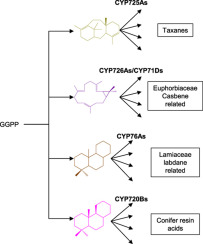当前位置:
X-MOL 学术
›
Phytochemistry
›
论文详情
Our official English website, www.x-mol.net, welcomes your
feedback! (Note: you will need to create a separate account there.)
Cytochrome P450 enzymes: A driving force of plant diterpene diversity
Phytochemistry ( IF 3.2 ) Pub Date : 2019-05-01 , DOI: 10.1016/j.phytochem.2018.12.003 Ulschan Bathe , Alain Tissier
Phytochemistry ( IF 3.2 ) Pub Date : 2019-05-01 , DOI: 10.1016/j.phytochem.2018.12.003 Ulschan Bathe , Alain Tissier

|
In plant terpene biosynthesis, oxidation of the hydrocarbon backbone produced by terpene synthases is typically carried out by cytochrome P450 oxygenases (CYPs). The modifications introduced by CYPs include hydroxylations, sequential oxidations at one position and ring rearrangements and closures. These reactions significantly expand the structural diversity of terpenoids, but also provide anchoring points for further decorations by various transferases. In recent years, there has been a significant increase in reports of CYPs involved in plant terpene pathways. Plant diterpenes represent an important class of metabolites that includes hormones and a number of industrially relevant compounds such as pharmaceutical, aroma or food ingredients. In this review, we provide a comprehensive survey on CYPs reported to be involved in plant diterpene biosynthesis to date. A phylogenetic analysis showed that only few CYP clans are represented in diterpene biosynthesis, namely CYP71, CYP85 and CYP72. Remarkably few CYP families and subfamilies within those clans are involved, indicating specific expansion of these clades in plant diterpene biosynthesis. Nonetheless, the evolutionary trajectory of CYPs of specialized diterpene biosynthesis is diverse. Some are recently derived from gibberellin biosynthesis, while others have a more ancient history with recent expansions in specific plant families. Among diterpenoids, labdane-related diterpenoids represent a dominant class. The availability of CYPs from diverse plant species able to catalyze oxidations in specific regions of the labdane-related backbones provides opportunities for combinatorial biosynthesis to produce novel diterpene compounds that can be screened for biological activities of interest.
中文翻译:

细胞色素 P450 酶:植物二萜多样性的驱动力
在植物萜生物合成中,萜烯合酶产生的烃骨架的氧化通常由细胞色素 P450 加氧酶 (CYP) 进行。CYPs 引入的修饰包括羟基化、一个位置的连续氧化以及环的重排和闭合。这些反应显着扩展了萜类化合物的结构多样性,但也为各种转移酶的进一步修饰提供了锚定点。近年来,有关 CYPs 参与植物萜烯途径的报道显着增加。植物二萜代表了一类重要的代谢物,包括激素和许多工业相关化合物,如药物、香气或食品成分。在这次审查中,我们对迄今为止报道的参与植物二萜生物合成的 CYP 进行了全面调查。系统发育分析表明,只有少数 CYP 族存在于二萜生物合成中,即 CYP71、CYP85 和 CYP72。这些氏族中很少有 CYP 家族和亚家族参与其中,表明这些进化枝在植物二萜生物合成中的特定扩展。尽管如此,专门的二萜生物合成的 CYP 的进化轨迹是多种多样的。一些最近来源于赤霉素生物合成,而另一些则具有更古老的历史,最近在特定植物科中进行了扩展。在二萜类化合物中,劳丹烷相关的二萜类化合物占主导地位。
更新日期:2019-05-01
中文翻译:

细胞色素 P450 酶:植物二萜多样性的驱动力
在植物萜生物合成中,萜烯合酶产生的烃骨架的氧化通常由细胞色素 P450 加氧酶 (CYP) 进行。CYPs 引入的修饰包括羟基化、一个位置的连续氧化以及环的重排和闭合。这些反应显着扩展了萜类化合物的结构多样性,但也为各种转移酶的进一步修饰提供了锚定点。近年来,有关 CYPs 参与植物萜烯途径的报道显着增加。植物二萜代表了一类重要的代谢物,包括激素和许多工业相关化合物,如药物、香气或食品成分。在这次审查中,我们对迄今为止报道的参与植物二萜生物合成的 CYP 进行了全面调查。系统发育分析表明,只有少数 CYP 族存在于二萜生物合成中,即 CYP71、CYP85 和 CYP72。这些氏族中很少有 CYP 家族和亚家族参与其中,表明这些进化枝在植物二萜生物合成中的特定扩展。尽管如此,专门的二萜生物合成的 CYP 的进化轨迹是多种多样的。一些最近来源于赤霉素生物合成,而另一些则具有更古老的历史,最近在特定植物科中进行了扩展。在二萜类化合物中,劳丹烷相关的二萜类化合物占主导地位。











































 京公网安备 11010802027423号
京公网安备 11010802027423号